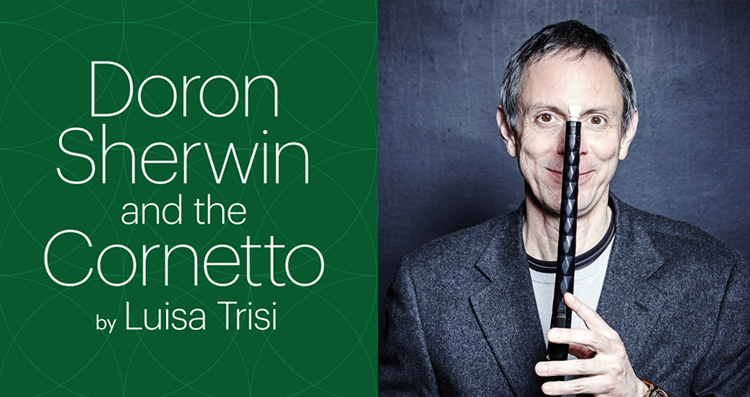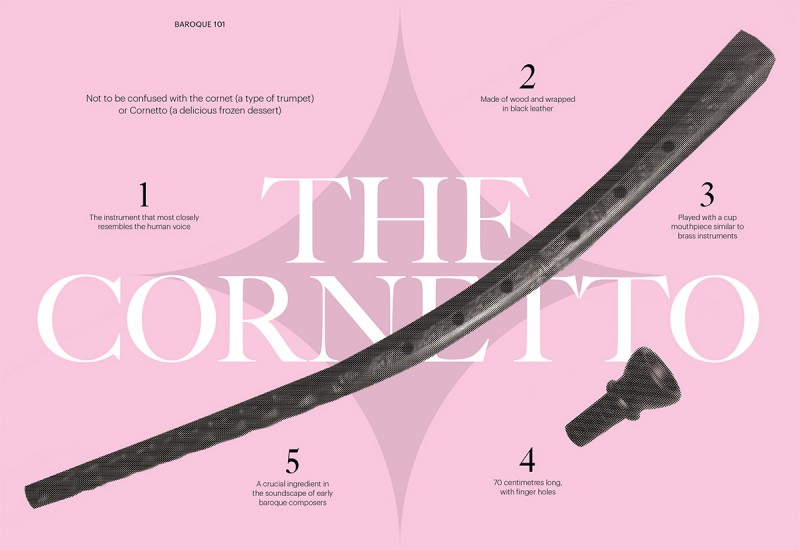This article is drawn from the first issue of Tafel: our new magazine for the musically curious. Offered three times a year, this publication will, we hope, welcome new friends as well as extend the rich conversations we are already having with so many of you. Read the entire first issue here.
Doron Sherwin and the cornetto
By Luisa Trisi
How does the son of two Hollywood nightclub singers become one of the world’s leading period instrumentalists specializing in the notoriously demanding cornetto? Speaking from Bologna, Italy, the “sensational” (The New York Times) cornettist Doron Sherwin describes growing up in a home where he was steeped in his parents’ music—1940s and 50s jazz and swing, and later rock and pop: “there were musicians coming and going all the time at our house and I was surrounded by every different kind of music imaginable.”
Sherwin’s fascination with the cornetto can be traced back to his primary school years, when children routinely learned to play the recorder, a simple wooden instrument with a mouthpiece and finger holes. “A recorder was thrust into my hands and I became so interested that I started to study it seriously. It was a natural progression to explore the instrument’s history and repertoire, which goes way, way back. I started listening to records of mostly renaissance and early baroque music that I checked out of the local library. I was utterly fascinated by the very exotic sounds of all the different wind instruments of the era, including the cornetto. It was the sounds of those instruments and the sound of the music itself that captured me.”
Prized for its purity of tone, the cornetto was long regarded as the instrument that most closely resembled the sound of the human voice. The 17th-century French writer Marin Mersenne compared its sound to “the brilliance of a shaft of sunlight appearing in the shadow or in darkness, when one hears it among the voices in cathedrals or in chapels.”
Sherwin will never forget the experience of hearing the cornetto live for the first time at age 18. “There was a young gentleman from California, Michael Collver, who became one of my very first cornetto teachers. He played in such an extraordinarily expressive way that I was absolutely mesmerized by the cornetto and what it could do.”
The wooden, leather-bound instrument’s soaring timbre is a quintessential ingredient in the soundscape of renaissance and early baroque composers. “I often describe it as being a hybrid that combines the disadvantages of two very different instruments,” says Sherwin. “It blends the cup mouthpiece used in brass instruments and the wooden body and fingerholes typical of the woodwinds—a combination that renders the instrument especially difficult to control.”
While the unique technical demands pose a challenge for any cornetto player, Sherwin notes that it is precisely this combination of characteristics that produces the instrument’s rich and expressive palette. “As the Germans say, it’s neither fish nor meat. It’s a hybrid that sits astride two different families of instruments. It seems to me a sort of saxophone of the renaissance or early baroque.”
Since leaving his native California in 1984, Sherwin has performed on the cornetto around the world with internationally acclaimed ensembles such as Hespérion XXI, Amsterdam Baroque Orchestra, Taverner Players, Hilliard Ensemble, L’Arpeggiata, and especially as a member of Concerto Palatino, one of world’s top early brass groups.
Sherwin’s first Toronto appearance takes place in October 2020 at the invitation of Tafelmusik Music Director Elisa Citterio, whom he met years ago when they were both performing with the renowned ensemble Concerto Italiano under Rinaldo Alessandrini—another guest director making his Tafelmusik debut in the 2020/21 season. “I’ve performed several times in Montreal and Vancouver, but never before in Toronto. I’m really, really looking forward to playing there.”
Other Canadian connections include the Montreal-based cornettist and baroque oboist Matthew Jennejohn, who makes all of Sherwin’s instruments. Co-founder of the cornetto and sackbutt ensemble La Rose des Vents, Jennejohn has also performed with Tafelmusik and Arion Baroque Orchestra.
Though jazz and the music of the 16th and 17th centuries may appear to be worlds apart, Sherwin sees clear parallels between them. Even his email address is a clever pun on the name of a legendary jazz saxophonist. It’s no surprise that he is delighted to be recognized for his “uncanny ability to bring the syncopating spirit of Dizzy Gillespie to cornetto playing” (MusicOMH). Sherwin explains, “one of the most basic things worth noting is the distinction we now have between performers and composers, which did not exist in the renaissance and baroque. All of the best composers were charismatic, fantastic performers, and all of the best performers were schooled in composition—they knew how to write music. Many of the great composers back then were known as extraordinarily exciting and compelling performers and improvisers.”
Like their counterparts in the world of jazz, the musicians of the 16th and 17th centuries were provided with only the most basic chords or the suggestion of a melody over which they were required to improvise. “Musicians were expected to add a lot of their own embellishments. The written score was not a finished product in itself. Just like the architecture and everyday objects of those days were richly ornamented—the buildings and even the chairs and spoons—the music from that time requires a kind of spontaneous decoration as well. And not just cornetto players, but singers, violinists, keyboard players, lute players—they were all doing this sort of thing and it was expected of them, otherwise they weren’t considered very competent musicians. The ornaments are not just some added frill that you can do without. No, they are a fundamental part of the composition, just like they would be in architecture.”
Tafelmusik audiences will get a taste of this fluid improvisation and ornamentation in November, when Sherwin directs Cornetto Freestyle, a program he created around the theme of spontaneous invention.
Despite the beauty of its sound and remarkable expressive capability, the cornetto fell out of favour by the end of the 18th century. Sherwin attributes the instrument’s decline, in part, to the extraordinary level of precision and control required to master it. “The cornetto has always been known as an extremely difficult instrument to play, with many technical hurdles to overcome before a player achieves a properly sustained and beautiful sound, clean intonation, and tasteful phrasing. In fact, even when it was highly regarded as a virtuoso solo instrument, it was considered the most difficult instrument of its age. That’s why some of the most distinguished players were extremely well-paid and highly sought after back then. They had international careers and were like the opera singers and basketball players of today.”
Fortunately, thanks to the efforts of innovative musicians like Sherwin and his mentor Bruce Dickey, the cornetto has been enjoying a revival that has been gaining momentum since the 1950s. “Bruce is the one player who’s done more than anyone else to promote and revive the cornetto as a truly virtuoso instrument,” says Sherwin. Over the past three decades, Dickey, Sherwin, and their protégées have helped nurture a new cohort of performers who are restoring the cornetto’s status as “the king of all instruments.” From Dickey’s “Cornettomania” online resource to Sherwin’s concerts with Tafelmusik, cornetto love is spreading. A new generation of listeners is being introduced to this breathtaking instrument that was once at risk of being forgotten.
Doron Sherwin guest directs Tafelmusik’s Cornetto Freestyle concerts November 5 to 8, 2020 at Jeanne Lamon Hall, Trinity-St. Paul’s Centre.
Photo credit: Michael Novak


